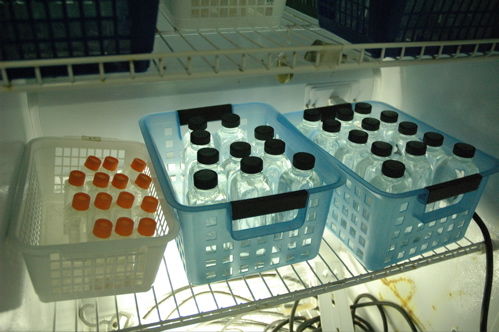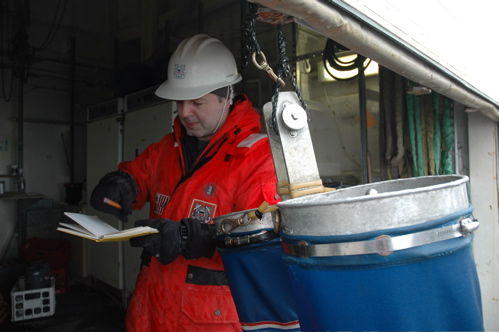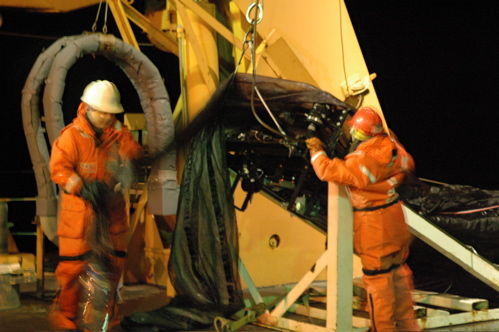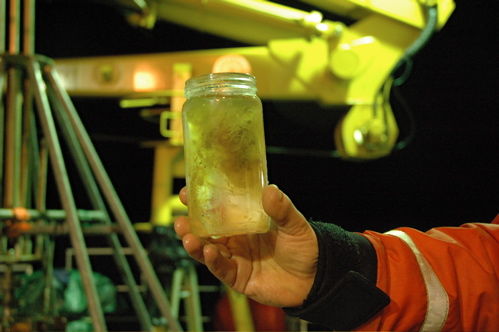Latitude: 57 10.174N Longitude: 163 45.851W Alexei Pinchuk peers into a clear plastic bottle that he has taken out of the fridge outside the lab. If you didn't know better, you would think that he was looking at a bottle of chilly water. What he is actually doing is checking on his babies...his baby krill, that is. Looking closely into the bottle I can see three teeny organisms swimming around. Each of them is smaller than a grain of rice and as clear as cellophane. The only colors visible are a little pink dot by their tail and a green spot, in the middle. This green stuff tells Alexei that these one month-old krill have been busy eating. He hopes this means that they will continue to grow.
So why does Alexei, a scientist at the University of Alaska, have a fridge full of krill babies? His role as a member of the nocturnal krill team is that of Poppa Krill. By harvesting gravid (pregnant) females from the various tows each night, he hopes to obtain eggs and raise the babies. He works with the University of Maryland researchers that are trying to establish an index for identifying the age of krill. Right now, the scientists can compare the ages of different krill, or establish relative age, but there is no way to know their exact age. Using Alexei's krill, the UMD team will then be able to look for age-tracers in a population of krill that they know the age of for certain.
Female krill turn blue when they are ready to reproduce. This is a pretty good signal for Alexei when he is deciding whom to keep for his study. "The tricky part is getting the gravid females and then getting the eggs.", he explains. He collects these blue ladies in the hopes that they will follow through and lay eggs. On this trip he has gotten his wish. He has successfully collected eggs, which have now hatched into young krill. This is what he was watching swim around in the refrigerator bottles while I talked to him yesterday. These guys were one month old and still developing. In fact, they hadn't even developed eyes yet! Can you imagine a one month-old baby not being able to see yet?!

Krill, it turns out, are pretty complex and delicate animals. They go through many life stages and successive molts before reaching maturity. Many different variables factor into their ability to successfully grow and reproduce. The most important of these are temperature (when they are very young) and availability of quality food (when they are older). Molting and reproduction are high-energy activities so without proper food stores in the form of lipids (fats), it's not likely that development will be successful.
Alexei's personal research interests are not limited to krill, however. He also studies plankton. He uses two netting systems to collect his samples. The Calvets look like a pair of pants when they go into the water off the back deck. Two long nets follow the figure-eight shaped frame as it is towed behind the ship. He investigates plankton abundance, biomass (how much, how dense) and distribution (how far it is spread out).

In search of still more plankton, I found myself on the fantail again at 1:30am with Alexei's second kind of sampling net, the MocNess. The MocNess is a contraption that few people on the cruise have ever even seen operate. It sits shrouded in its own nets on the back deck, silently waiting for Alexei to unwrap it and send it out in search of plankton. The nets on the MocNess are much finer than most of the other towing contraptions. The finer mesh allows for more animals to get caught in it. It also reduces the amount of water pressure that the little animal bodies are battered with as the net drags through the water. These nets pull up animal samples that are relatively unharmed.
We deployed the MocNess off the fantail in a May snow-shower and then headed up to the control center where Alexei monitored how fast the ship was traveling, how much volume was traveling through the nets and how quickly the whole contraption was moving through the water. By communicating with the boat driver, he could make small adjustments to ensure that he was collecting the samples that he wanted. Meanwhile, the MocNess was drifting silently deeper and deeper. At each station, Alexei watches its movements carefully through remote sensors and decides which depths he wants to take samples from. By closing the series of nets at different depths, he can capture representative samples at different spots in the water column.

Once the nets come back on deck, the cod ends (the bottles at the end of the nets) are snapped off and the samples are filtered. Take a look at what we caught last night...


We're not done yet though! Resetting the nets means reversing the process with the cod ends (re-snapping them into place), replacing the nets and then snapping in a series of release bars. At 3:00am we were ready and in place for the second tow which was only one station and 30 minutes away! The propellers went to work and we steered in the direction of the next sample station two miles away through the dark and chilly waters...


Comments